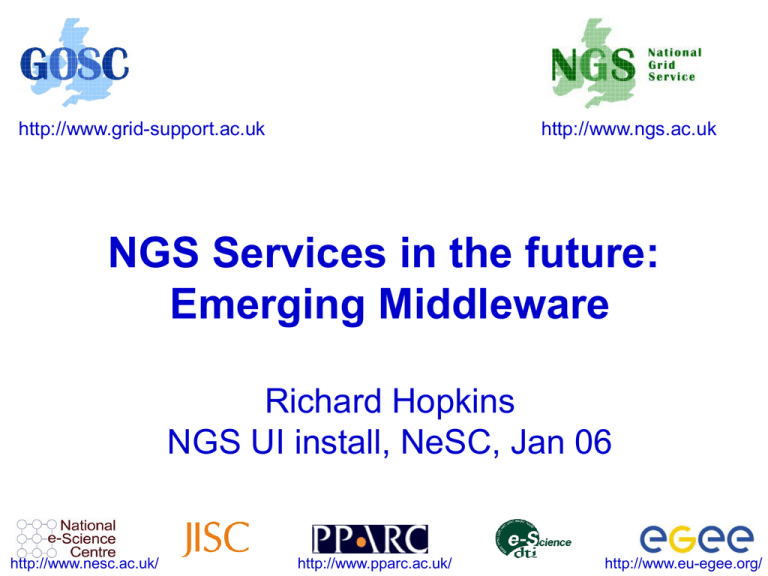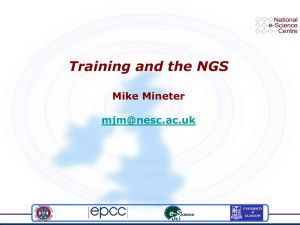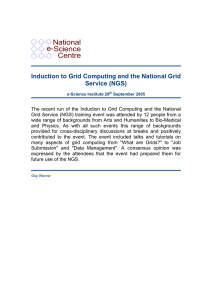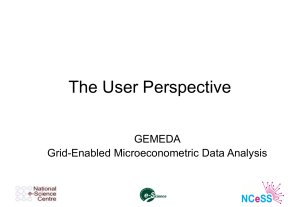NGS Services in the future: Emerging Middleware Richard Hopkins
advertisement

http://www.grid-support.ac.uk
http://www.ngs.ac.uk
NGS Services in the future:
Emerging Middleware
Richard Hopkins
NGS UI install, NeSC, Jan 06
http://www.nesc.ac.uk/
http://www.pparc.ac.uk/
http://www.eu-egee.org/
Goal of talk
• The NGS is running a production service
• Different middleware may be deployed in the
future.
• The talk seeks to outline some of the
possibilities
NGS UI install – NGS Future Services, Emerging
Middleware; R Hopkins, Jan 06
3
GOSC Strategy
•
Strategic Framework recognises:
– Need for clear goals and quality control of any new
GOSC services.
– GOSC should have a service focus and not a
technology focus.
– Compatibility with emerging European eInfrastructure (EGEE).
– Importance of Shibboleth for authentication and
authorisation.
– Service based grid infrastructure remains the goal of
the GOSC
NGS UI install – NGS Future Services, Emerging
Middleware; R Hopkins, Jan 06
4
NGS middleware evolution
EGEE…
Other software
sources
Prototypes &
specifications
‘Gold’ services
NGS
ETF
Software with proven
capability & realistic
deployment
experience
UK,
Operations Campus
and other
grids
Feedback & future requirements
Engineering Task Force
Deployment/testing/advice
NGS UI install – NGS Future Services, Emerging
Middleware; R Hopkins, Jan 06
5
Outline of current Status
• Middleware recently deployed
– Portal v2
– INCA monitoring: http://inca.grid-support.ac.uk/
• Being prepared for deployment
– Resource broker
• Under assessment / observation
– gLite middleware from EGEE
– OMII middleware
– GT4
• Under development
– Shibboleth integration
NGS UI install – NGS Future Services, Emerging
Middleware; R Hopkins, Jan 06
6
EGEE Resource broker
• (This is NOT the SRB!!!)
• Current NGS middleware comprises toolkits
inviting development of higher level services
• On the current NGS we have
– GRAM to submit jobs
– Information service to tell us what queues are busy
• The RB will take the work out of deciding where
to run a job
– Submit job to the grid, not a specified “compute
element”
NGS UI install – NGS Future Services, Emerging
Middleware; R Hopkins, Jan 06
7
EGEE grid - Major components
“User
interface”
Input “sandbox”
Output “sandbox”
DataSets info
Replica
Catalogue
Information
Service
Resource
Broker
Publish
Logging &
Book-keeping
Job Query
Job Submit Event
Author.
&Authen.
Storage
Element
Job Status
Computing
Element
Middleware components in EGEE - 8
EGEE Resource broker
• Job Description Language file: describes
resources needed by a job
• Commands analogous to GT2:
– edg-job-submit <jdl filename>
– edg-job-status <dg-job-id>
– edg-job-get-output <dg-job-id>
• Why “edg”?
– This RB was developed initially by the European Data
Grid project and inherited by EGEE
NGS UI install – NGS Future Services, Emerging
Middleware; R Hopkins, Jan 06
9
Example
• edg-job-submit myjob.jdl
– Myjob.jdl
• JobType = “Normal”;
• Executable = "$(CMS)/exe/sum.exe";
• InputSandbox = {"/home/user/WP1testC","/home/file*”,
"/home/user/DATA/*"};
• OutputSandbox = {“sim.err”, “test.out”, “sim.log"};
• Requirements = other. GlueHostOperatingSystemName ==
“linux" &&
• other. GlueHostOperatingSystemRelease == "Red Hat 7.3“
&& other.GlueCEPolicyMaxCPUTime > 10000;
• Rank = other.GlueCEStateFreeCPUs;
NGS UI install – NGS Future Services, Emerging
Middleware; R Hopkins, Jan 06
10
Resource broker summary
• The resource broker receives a job description
in JDL
• It chooses a batch queue for job submission,
using the information services
• Its an example of the higher services that can be
deployed for the NGS, built upon the current
toolkits
NGS UI install – NGS Future Services, Emerging
Middleware; R Hopkins, Jan 06
12
EGEE – international e-infrastructure
Enabling Grids for E-sciencE
A four year programme:
•
•
•
Build, deploy and operate a
consistent, robust a large
scale production grid service
that
– Links with and build on
national, regional and
international initiatives
Improve and maintain the
middleware in order to deliver
a reliable service to users
Pan-European Grid
Attract new users from
research and industry and
ensure training and support
for them
INFSO-RI-508833
Operations, Support and
training
Collaboration
Network
infrastructure
& Resource
centres
An introduction to EGEE
13
In the first 2 years EGEE is
Enabling Grids for E-sciencE
• Establishing production quality sustained
Grid services
– 3000 users from at least 5 disciplines
– integrate 50 sites into a common
infrastructure
– offer 5 Petabytes (1015) storage
• Demonstrating a viable general process to
bring other scientific communities on board
• Proposed a second phase to take over
EGEE in April 2006
INFSO-RI-508833
Pilot
An introduction to EGEE
New
14
EGEE Organisation
Enabling Grids for E-sciencE
• 70 leading institutions in 27
countries, federated in regional Grids
• ~32 M Euros EU funding for first 2
years starting April 2004
(matching funds from partners)
• Leveraging national and regional grid
activities
• Promoting scientific partnership
outside EU
INFSO-RI-508833
An introduction to EGEE
15
gLite: Guiding Principles
Enabling Grids for E-sciencE
•
VDT
EDG
...
AliEn
LCG
...
Service oriented approach
– Allow for multiple interoperable
implementations
•
Lightweight (existing) services
– Easily and quickly deployable
– Use existing services where
possible
Condor, EDG, Globus, LCG, …
•
Portable
– Being built on Scientific Linux and
Windows
•
•
Security
– Co-existence with LCG-2 and OSG
(US) are essential for the EGEE
Grid services
– Sites and Applications
•
Performance/Scalability &
Resilience/Fault Tolerance
•
Site autonomy
– Reduce dependence on ‘global,
central’ services
– Comparable to deployed
infrastructure
•
INFSO-RI-508833
Co-existence with deployed
infrastructure
Open source license
An introduction to EGEE
16
EGEE is running…
Enabling Grids for E-sciencE
• … the largest multi-VO production grid in the world!
• What’s happening now?
http://gridportal.hep.ph.ic.ac.uk/rtm/
• What resources are connected?
http://goc.grid-support.ac.uk/gridsite/monitoring/
INFSO-RI-508833
An introduction to EGEE
17
Open Middleware
Infrastructure Institute
OMII goal: to be the source of open source grid
software
Institute of the University of Southampton
Utilise existing software and standards
Production focused software development
Integrate, test & document ‘a product’
Focus on the user experience
Easy to install & use
Utilise existing software and standards
Provide a solid web service base for others to build on
©
19
Where does our software come
from?
Open Source Community
Software Repository
Tomcat, Axis, etc.,
Accept software contributions
Software deployed, tested & graded to provide
feedback
Managed Programme
Fill gaps to build a solid enabling infrastructure
Projects to bring research software to production
quality
©
20
Managed Programme
GridSAM (Job Submission & Monitoring service)
BPEL (Workflow service)
Grimoires (Registry service based on UDDI)
FIRMS (Reliable messaging)
FINS (Notification)
GeodiseLab (Matlab toolbox)
WSRF::Lite integration
OGSA-DAI (Database service)
WSeSS (Using SSH to tunnel requests to resources)
©
21
OMII_1 release:
A basic File-Compute Grid
Enables a generic computational task
Move input data from the client to the service
provider
Process the data using an application on the
service provider
Retrieve the output data from the service
provider
©
22
OMII - 1 Server Infrastructure
PBAC
ExampleService
TestService
Job
Data
Allocation
Account
Resource Acct
Mgmt
Mgmt
Servlet Servlet
Happy
Axis
WS-Security
AXIS
Static Webpage
TOMCAT
©
23
Try out the OMII_2 client !
Register at www.omii.ac.uk & login
Goto the downloads page
Download the client distribution
SuSE 9.0
Client may work on other Linuxs but no
exhaustive testing
Windows XP (SP 1 & 2)
©
24
The Road Ahead
• GOSC aim to deploy a Web/Grid Services based infrastructure.
– Has proved significantly more challenging than originally hoped.
• several years to develop the stable GT2 based middleware to a production
state
• Re-implementing this knowledge as robust web services has not proved
simple.
• Upheaval around OGSI also delayed coherent application
development
• WS standards are emerging more slowly than originally hoped.
• Uncertainty about the security models adds further uncertainty
– JISC adoption of Shibboleth has not reduced the confusion.
– Recent initiatives in the US and UK have only just begun to address
grid/shibboleth integration.
– Work towards authentication and authorisation based on users
institutional identity
NGS UI install – NGS Future Services, Emerging
Middleware; R Hopkins, Jan 06
25
Strategy for the Future
•
OGSA remains important to the future development of the NGS
– OGSA addresses the fundamental capabilities/services needed to build grids
– OGSA is only beginning to deliver on first specs (Basic Execution Services)
– There are encouraging signs.
• The Job Submission Description Language standard
• A storage interface –SRM- has been agreed across a large number of grid
projects (though only a limited set of implementations of this standard exist)
• common information schema, the GLUE schema, is in common use around
the world..
•
“middleware hardening” activities such as the UK’s Open Middleware
Infrastructure Initiative will be crucial to out future success.
– take emerging standards/early implementations -> to robust and user friendly
implementations.
– The world does not need yet another job submission interface, it needs a robust
implementation of the agreed and tested open standards!.
NGS UI install – NGS Future Services, Emerging
Middleware; R Hopkins, Jan 06
26
Outline of current Status
• Middleware recently deployed
– Portal v2
– INCA monitoring: http://inca.grid-support.ac.uk/
• Being prepared for deployment
– Resource broker
• Under assessment / observation
– gLite middleware from EGEE
– OMII middleware
– GT4
• Under development
– Shibboleth integration
NGS UI install – NGS Future Services, Emerging
Middleware; R Hopkins, Jan 06
27


